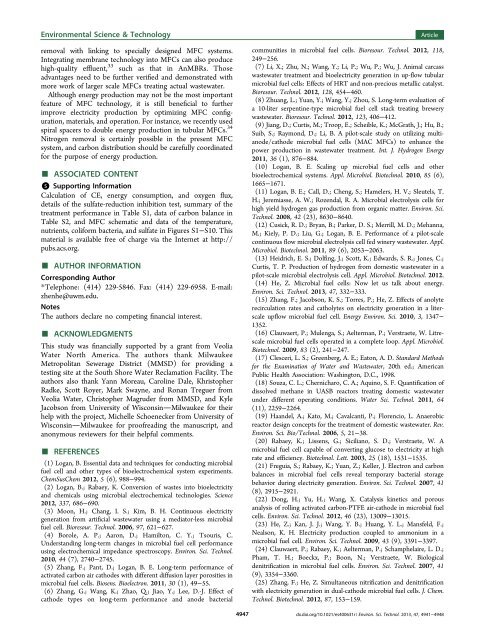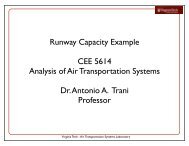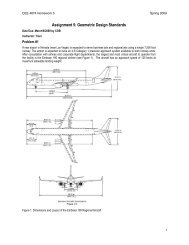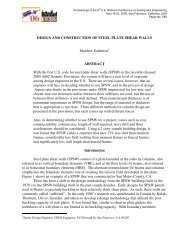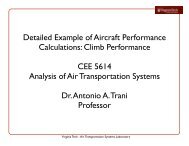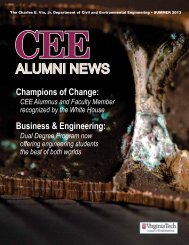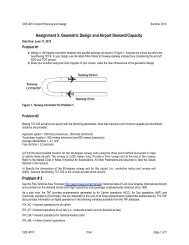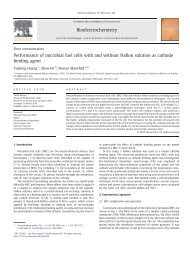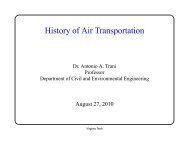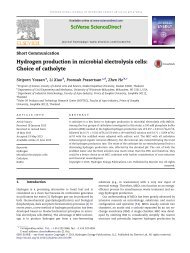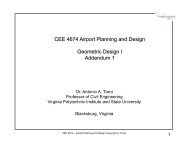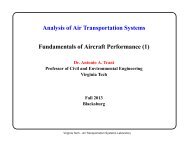Long-Term Performance of Liter-Scale Microbial Fuel Cells Treating ...
Long-Term Performance of Liter-Scale Microbial Fuel Cells Treating ...
Long-Term Performance of Liter-Scale Microbial Fuel Cells Treating ...
You also want an ePaper? Increase the reach of your titles
YUMPU automatically turns print PDFs into web optimized ePapers that Google loves.
Environmental Science & TechnologyArticleremoval with linking to specially designed MFC systems.Integrating membrane technology into MFCs can also producehigh-quality effluent, 33 such as that in AnMBRs. Thoseadvantages need to be further verified and demonstrated withmore work <strong>of</strong> larger scale MFCs treating actual wastewater.Although energy production may not be the most importantfeature <strong>of</strong> MFC technology, it is still beneficial to furtherimprove electricity production by optimizing MFC configuration,materials, and operation. For instance, we recently usedspiral spacers to double energy production in tubular MFCs. 34Nitrogen removal is certainly possible in the present MFCsystem, and carbon distribution should be carefully coordinatedfor■the purpose <strong>of</strong> energy production.ASSOCIATED CONTENT*S Supporting InformationCalculation <strong>of</strong> CE, energy consumption, and oxygen flux,details <strong>of</strong> the sulfate-reduction inhibition test, summary <strong>of</strong> thetreatment performance in Table S1, data <strong>of</strong> carbon balance inTable S2, and MFC schematic and data <strong>of</strong> the temperature,nutrients, coliform bacteria, and sulfate in Figures S1−S10. Thismaterial is available free <strong>of</strong> charge via the Internet at http://pubs.acs.org.■ AUTHOR INFORMATIONCorresponding Author*Telephone: (414) 229-5846. Fax: (414) 229-6958. E-mail:zhenhe@uwm.edu.NotesThe authors declare no competing financial interest.■ ACKNOWLEDGMENTSThis study was financially supported by a grant from VeoliaWater North America. The authors thank MilwaukeeMetropolitan Sewerage District (MMSD) for providing atesting site at the South Shore Water Reclamation Facility. Theauthors also thank Yann Moreau, Caroline Dale, KhristopherRadke, Scott Royer, Mark Swayne, and Ronan Treguer fromVeolia Water, Christopher Magruder from MMSD, and KyleJacobson from University <strong>of</strong> WisconsinMilwaukee for theirhelp with the project, Michelle Schoenecker from University <strong>of</strong>WisconsinMilwaukee for pro<strong>of</strong>reading the manuscript, andanonymous reviewers for their helpful comments.■ REFERENCES(1) Logan, B. Essential data and techniques for conducting microbialfuel cell and other types <strong>of</strong> bioelectrochemical system experiments.ChemSusChem 2012, 5 (6), 988−994.(2) Logan, B.; Rabaey, K. Conversion <strong>of</strong> wastes into bioelectricityand chemicals using microbial electrochemical technologies. Science2012, 337, 686−690.(3) Moon, H.; Chang, I. S.; Kim, B. H. Continuous electricitygeneration from artificial wastewater using a mediator-less microbialfuel cell. Bioresour. Technol. 2006, 97, 621−627.(4) Borole, A. P.; Aaron, D.; Hamilton, C. Y.; Tsouris, C.Understanding long-term changes in microbial fuel cell performanceusing electrochemical impedance spectroscopy. Environ. Sci. Technol.2010, 44 (7), 2740−2745.(5) Zhang, F.; Pant, D.; Logan, B. E. <strong>Long</strong>-term performance <strong>of</strong>activated carbon air cathodes with different diffusion layer porosities inmicrobial fuel cells. Biosens. Bioelectron. 2011, 30 (1), 49−55.(6) Zhang, G.; Wang, K.; Zhao, Q.; Jiao, Y.; Lee, D.-J. Effect <strong>of</strong>cathode types on long-term performance and anode bacterial4947communities in microbial fuel cells. Bioresour. Technol. 2012, 118,249−256.(7) Li, X.; Zhu, N.; Wang, Y.; Li, P.; Wu, P.; Wu, J. Animal carcasswastewater treatment and bioelectricity generation in up-flow tubularmicrobial fuel cells: Effects <strong>of</strong> HRT and non-precious metallic catalyst.Bioresour. Technol. 2012, 128, 454−460.(8) Zhuang, L.; Yuan, Y.; Wang, Y.; Zhou, S. <strong>Long</strong>-term evaluation <strong>of</strong>a 10-liter serpentine-type microbial fuel cell stack treating brewerywastewater. Bioresour. Technol. 2012, 123, 406−412.(9) Jiang, D.; Curtis, M.; Troop, E.; Scheible, K.; McGrath, J.; Hu, B.;Suib, S.; Raymond, D.; Li, B. A pilot-scale study on utilizing multianode/cathodemicrobial fuel cells (MAC MFCs) to enhance thepower production in wastewater treatment. Int. J. Hydrogen Energy2011, 36 (1), 876−884.(10) Logan, B. E. Scaling up microbial fuel cells and otherbioelectrochemical systems. Appl. Microbiol. Biotechnol. 2010, 85 (6),1665−1671.(11) Logan, B. E.; Call, D.; Cheng, S.; Hamelers, H. V.; Sleutels, T.H.; Jeremiasse, A. W.; Rozendal, R. A. <strong>Microbial</strong> electrolysis cells forhigh yield hydrogen gas production from organic matter. Environ. Sci.Technol. 2008, 42 (23), 8630−8640.(12) Cusick, R. D.; Bryan, B.; Parker, D. S.; Merrill, M. D.; Mehanna,M.; Kiely, P. D.; Liu, G.; Logan, B. E. <strong>Performance</strong> <strong>of</strong> a pilot-scalecontinuous flow microbial electrolysis cell fed winery wastewater. Appl.Microbiol. Biotechnol. 2011, 89 (6), 2053−2063.(13) Heidrich, E. S.; Dolfing, J.; Scott, K.; Edwards, S. R.; Jones, C.;Curtis, T. P. Production <strong>of</strong> hydrogen from domestic wastewater in apilot-scale microbial electrolysis cell. Appl. Microbiol. Biotechnol. 2012.(14) He, Z. <strong>Microbial</strong> fuel cells: Now let us talk about energy.Environ. Sci. Technol. 2013, 47, 332−333.(15) Zhang, F.; Jacobson, K. S.; Torres, P.; He, Z. Effects <strong>of</strong> anolyterecirculation rates and catholytes on electricity generation in a literscaleupflow microbial fuel cell. Energy Environ. Sci. 2010, 3, 1347−1352.(16) Clauwaert, P.; Mulenga, S.; Aelterman, P.; Verstraete, W. Litrescalemicrobial fuel cells operated in a complete loop. Appl. Microbiol.Biotechnol. 2009, 83 (2), 241−247.(17) Clesceri, L. S.; Greenberg, A. E.; Eaton, A. D. Standard Methodsfor the Examination <strong>of</strong> Water and Wastewater, 20th ed.; AmericanPublic Health Association: Washington, D.C., 1998.(18) Souza, C. L.; Chernicharo, C. A.; Aquino, S. F. Quantification <strong>of</strong>dissolved methane in UASB reactors treating domestic wastewaterunder different operating conditions. Water Sci. Technol. 2011, 64(11), 2259−2264.(19) Haandel, A.; Kato, M.; Cavalcanti, P.; Florencio, L. Anaerobicreactor design concepts for the treatment <strong>of</strong> domestic wastewater. Rev.Environ. Sci. Bio/Technol. 2006, 5, 21−38.(20) Rabaey, K.; Lissens, G.; Siciliano, S. D.; Verstraete, W. Amicrobial fuel cell capable <strong>of</strong> converting glucose to electricity at highrate and efficiency. Biotechnol. Lett. 2003, 25 (18), 1531−1535.(21) Freguia, S.; Rabaey, K.; Yuan, Z.; Keller, J. Electron and carbonbalances in microbial fuel cells reveal temporary bacterial storagebehavior during electricity generation. Environ. Sci. Technol. 2007, 41(8), 2915−2921.(22) Dong, H.; Yu, H.; Wang, X. Catalysis kinetics and porousanalysis <strong>of</strong> rolling activated carbon-PTFE air-cathode in microbial fuelcells. Environ. Sci. Technol. 2012, 46 (23), 13009−13015.(23) He, Z.; Kan, J. J.; Wang, Y. B.; Huang, Y. L.; Mansfeld, F.;Nealson, K. H. Electricity production coupled to ammonium in amicrobial fuel cell. Environ. Sci. Technol. 2009, 43 (9), 3391−3397.(24) Clauwaert, P.; Rabaey, K.; Aelterman, P.; Schamphelaire, L. D.;Pham, T. H.; Boeckx, P.; Boon, N.; Verstraete, W. Biologicaldenitrification in microbial fuel cells. Environ. Sci. Technol. 2007, 41(9), 3354−3360.(25) Zhang, F.; He, Z. Simultaneous nitrification and denitrificationwith electricity generation in dual-cathode microbial fuel cells. J. Chem.Technol. Biotechnol. 2012, 87, 153−159.dx.doi.org/10.1021/es400631r | Environ. Sci. Technol. 2013, 47, 4941−4948


